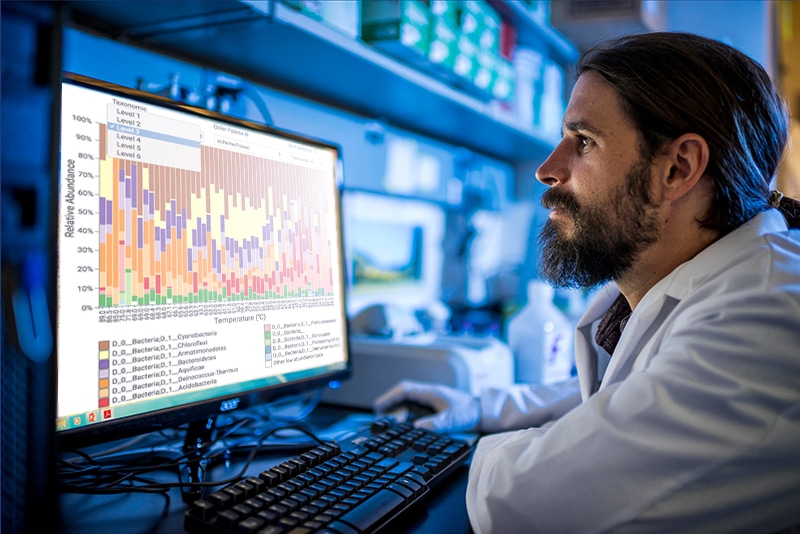July 24, 2019
In the last 20 years, rapid advances in DNA sequencing and bioinformatics technologies have significantly improved scientists’ understanding of the microbial world. Examples include increased knowledge about the vast diversity of microorganisms; how microbiota and microbiomes impact disease and medical treatment; how microorganisms impact the health of our planet; and the potential for applications of microbiome biotechnology in the medical, forensic, environmental and agricultural fields.
In 2009, Northern Arizona University associate professor Greg Caporaso of the Center for Applied Microbiome Science, part of the Pathogen and Microbiome Institute—who was at that time working as a postdoctoral scholar in Rob Knight’s laboratory, then at the University of Colorado at Boulder—led the development of the first open-source QIIME (Quantitative Insights Into Microbial Ecology) bioinformatics software platform under Knight’s guidance. An announcement of the software launch was published in Nature Methods in 2010. The software enables scientists to perform microbiome analysis from increasingly large amounts of DNA sequencing data, and was designed to take users from raw sequencing data through publication-quality graphics and statistics.
Since its initial release, QIIME (pronounced “chime”) has supported many microbiome studies and gained a broad user and developer community. In fact, QIIME has been cited in more than 15,000 academic papers, making it one of the most often-cited scholarly works by an NAU author.
Beginning in 2016, Caporaso and his team reengineered the platform to facilitate reproducible and modular analysis of microbiome data. The project to redesign and disseminate QIIME 2 was funded by a National Science Foundation grant awarded to Caporaso and Knight and is described in a paper published July 24 in Nature Biotechnology.
“As we interacted with QIIME users in our online support forum, in our workshops and through direct collaborations, we realized there was potential for better serving the growing community of microbiome researchers in academia, government and industry,” Caporaso said. “QIIME 2 retains the features that made QIIME a powerful and widely used analysis pipeline, while providing new features that will drive the next generation of microbiome research, including interactive spatial and temporal analysis and visualization tools; support for metabolomics and shotgun metagenomics analysis; and automated data provenance tracking to ensure reproducible, transparent microbiome data science.
“A core goal of QIIME 2 is to cultivate a diverse and inclusive community of scientists, software engineers, statisticians, educators, students and other microbiome stakeholders who are openly sharing methods, data and knowledge to advance microbiome research.”
A global community effort
Caporaso said QIIME 2 is a community effort that his team is leading. Collaborators on the project represent 77 research institutions from nine countries: Canada, China, Denmark, Germany, Italy, South Korea, the Netherlands, Australia and the United Kingdom.
NAU research software engineers Evan Bolyen, Matthew Dillon and Jai Ram Rideout performed the primary development of QIIME 2, along with postdoctoral scholar Nicholas Bokulich. Additional NAU collaborators include faculty researchers Paul Keim, Emily Cope and Tal Pearson; research staff Jorden Kreps and Charles HD Williamson; and students John Chase, Kestrel Gorlick, Chris Keefe, Ahmad Turan Naimey and Arron Shiffer.
“Advances in microbiome research promise to improve many aspects of our health and our world, and QIIME 2 will help drive those advances by enabling accessible, community-driven microbiome data science,” Caporaso said.
Caporaso and others on the team have already led 25 workshops for QIIME 2 users all over the world, including two workshops at the National Institutes for Health—each one attracting 75 participants—as well as a workshop for 40 students in Copenhagen, Denmark, conducted in June.
To learn more about QIIME 2, visit https://qiime2.org.
Image derived from DOI 10.1038/s41587-019-0209-9 published in Nature Biotechnology. See paper for list of authors.

Kerry Bennett
Office of the Vice President for Research



